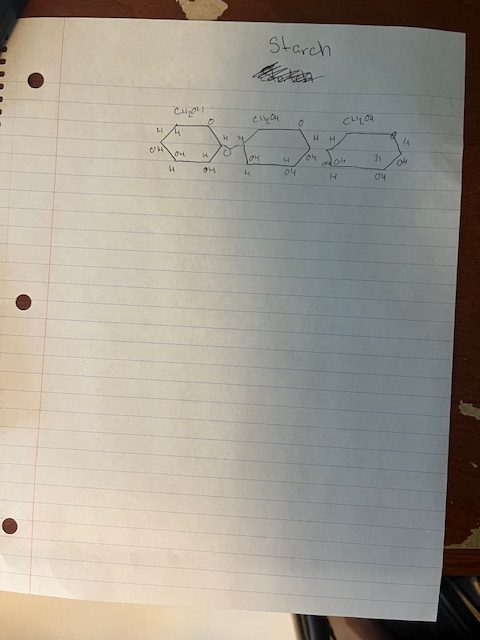Drawing of Eukaryotic Cell
Drawing of a Biomolecule (Starch)
Meme
I chose one of the rabbits from rabbit invasion because it is an accurate representation of my face as of now. I came into cell biology with what I thought was a pretty good understanding, and I was completely wrong. All of the new terminology, intricacies and the overall knowledge gained so far was a shock to me. One thing that stuck out to me was the cell membrane. I was under the impression that the cell membrane acted like a filter. Only allowing certain molecules that were under the filter size through. Through this course I learned that the membrane opens and closes due to outside signals. So far in this course, I am learning that there is always more information to be learned. It is essential to always seek new information in a topic even if you believe you are an “expert” on the topic. It is equally important to periodically check to see if any breakthroughs or changes have occurred in a topic. We’re always finding out something new!
Scientific Literature Essay
Cells are the building blocks of all living things. They make up bone tissue, muscle, cartilage and the list goes on. Without cells, life as a whole would cease to exist. The questions today are, “What is cellular senescence and is it the same thing as the G0 phase” and “What are promoter sequences and cryptic promoters”. In order to answer these questions, it is important to have a good understanding of the cell cycle.
A basic definition of the cell cycle is, “ to duplicate accurately the vast amount of DNA in the chromosomes and then segregate the copies precisely into two genetically identical daughter cells.” This observation is supported by Alberts, Johnson, Lewis, Raff, Roberts, Walter.1” The cell cycle can be broken up into two different phases, Interphase and the Mitotic phase. In Interphase, we have the G1 phase, S phase and G2 phase. G1 phase is where cellular content duplication occurs. Cells grow, mRNA synthesis occurs and translation which is protein synthesis. After the completion of G1 phase with no errors detected, the cell proceeds to S phase. In the S phase, DNA undergoes replication. With completion of the S phase with no detectable errors, it proceeds to the G2 phase. In the G2 phase, the cell continues to grow, prepares for Mitosis and does quality checks to make sure it is functioning properly. Once it’s completed its self evaluation it goes into M phase. As stated before, the M phase can be considered the second phase of the cell cycle. M phase is broken up into 4 parts, Prophase, Metaphase, Anaphase and Telophase. In prophase, chromatin condenses into chromosomes. After prophase, chromosomes line up in the middle of the cell (Metaphase). Chromosomes then break up at centromere and sister chromatids move towards opposite ends of the cell(Anaphase). Then the nuclear membrane reforms and nucleolus reappears and chromosomes unwind into chromatin. (Telophase). After Telophase the cell enters cytokinesis and this is where the parent cell divides into two daughter cells. Now that we have an understanding of the cell cycle we can now talk about the resting phase or G0 phase. This observation is supported by Alberts, Johnson, Lewis, Raff, Roberts, Walter.1″
G0 phase is a period in the cell cycle where a cell can divide or remain still, meaning not dividing. In this phase, the cell can either rest or it will perform necessary maintenance to re enter the cell cycle if it is missing certain criteria. Cellular senescence is, A period in which a cell can exit the cell cycle as a response to damage and to preserve its integrity. Multiple reports support this observation 3,7″. The difference between the two is, the G0 phase isn’t permanent while cellular senescence is. Cellular senescence is a permanent solution to cellular stress while G0 is a way for a cell to repair itself.
Promoter sequences are sequences of DNA that control where transcription of any gene begins. Cryptic promoters produce RNA molecules that don’t have a known function. The difference between cryptic transcription and normal transcription is, normal transcription makes RNA and is then used to make proteins while cryptic is made with no general purpose.
Proliferative is a term used to generally describe something that grows / increases at a fast rate. Relating that to biology, it is a term used to describe an increase in cell count due to cell growth and cell division i.e. proliferative cells. Senescent is a term used to describe the aging process. Senescent cells are a special type of cell that when it reaches a certain age, it stops multiplying but doesn’t die off.
One major difference between these two cell types is their transcription process/ transcription activity. For proliferative cells since they are always dividing, they have higher transcriptional activity in intergenic and promoter regions. In figure 1a for proliferative cells the amount of RNA that was generated by the promoter and intergenic regions was significantly higher than in senescent cells. The average percentage of RNA produced by the promoter was 11.95% and 31.05% for the intergenic regions between the two PRO-cap1 trials. Also noted by the figure, transcription mostly occurs in the genic region. This observation is supported by Sen et al.6″. Actively dividing cells need to produce RNA at the promoter to support their growth and division. In proliferative cells, cycle genes are also very active. Genes such as cyclins, CDKs and DNA polymerases are expressed in order to maintain the cell’s proliferative state. As stated above, since they are active, proliferative cells have transcription factors that promote cell progression instead of preventing it. Proliferative cells also have higher levels of histone variant proteins in transcription start sites. Histone variant proteins wrap around DNA and can either make it more accessible or inaccessible to transcriptional machinery. Activation modification can cause DNA to loosen off of the histone protein. With an increase of activation molecules it allows RNA polymerase to bind to DNA quicker and easier. Histone acetylation proteins also play an important role during transcription. Histone acetylation regulates transcription activation and is more present in chromatin in proliferative cells. Fig. 2c is showing chromatin accessibility. Zero on this plot corresponds to transcription start sites. This plot shows that proliferative cells have more chromatin and more activity closer to transcription start sites. Fig. 2d-h depicts acetylation of Histone tails. It was observed that the replicating cells showed no sizable difference between the acetylation of proliferative and senescent genes. I believe this is due to proliferative cells having so many processes that promote growth that there is no need for distinction. These characteristics found in proliferative cells are associated with transcriptional activation because they are geared towards promoting transcription, growth and division. Multiple reports support this observation 2,4,6″
On the contrary, senescent cells cannot divide anymore and so transcription activity is severely reduced. Since they don’t grow or divide, RNA does not need to be produced. In fig 1a, for senescent cells, the majority of transcription still occurs in the genetic region but there is a difference between the percentages. The average percentage of transcription activity in the promoter was 3.8% and 24.35% for the intergenic region. Comparing those percentages to proliferative cells, they are lower. It can be concluded that proliferative cells utilize the promoter and intergenic regions more than senescent cells. This observation is supported by Sen et al.6″
When it comes to genes related to the cell cycle, senescent cells have altered genes that downregulate other genes involved in the cell cycle. Meaning, they have things in place to insure that they can’t successfully grow and divide. It has also been observed that there is a slight increase in genes that cause cell damage (Inhibitors p16 and p21) . Lastly senescent cells have altered transcription factors which enables cell cycle arrest genes to take play. For senescent cells, they show reduced levels of histone acetylation near transcription start sites. In fig. in 2d-h, senescent cells showed a significant difference in acetylation of histone tails for proliferative and senescent genes. I believe this is due to the nature of senescent cells. Since they are geared towards shutting down, there is more transcription of silencing genes. Senescent cells also show altered histone variant proteins due to the closed chromatin structure. These characteristics found in senescent cells are associated with transcriptional silencing because they are all geared towards the shutting down of the cell. Multiple reports support this observation 4,5,6″
Senescent cells are a prime example of cryptic transcription. In fig. 1 b-f we are given 5 images showing transcription hot spots on introns using the PRO-seq and PRO-cap techniques. These hot spots (peaks) represent transcription start sites. In proliferative cells, there are no hot spots (peaks) on either the 5’ caps or 3’ tails for figures b-f. This is expected because introns shouldn’t have promoters. The lack of promoters is what gives the classification of an intron instead of the start of a new gene and this represents normal transcription. For senescent cells, figures b-f there are hot spots on both 5’ caps and 3’ tails. Another observation is that for each intron, senescent cells generally peak around the same area and size for both PRO-Cap and PRO-seq. From the hot spots, similar peaks on the cap and tail and the lack of peaks in proliferative cells, it can be deduced that senescent cells in these figures represent cryptic transcription. This observation is supported by Sen et al.6″
Genes for replicating cells using mono-methylation are enhancers. For tri methylation, replicating cells are promoters in proliferative conditions and are enhancers in senescent conditions. Genes for senescent cells using mono-methylation are promoters in both proliferative and senscent conditions. Genes for senescent cells using tri-methylation are enhancers in proliferating conditions but while in senescent conditions they are promoters. This observation is supported by Sen et al.6″
References
Alberts, B., Johnson, A., Lewis, J., Raff, M., Roberts, K., Walter, P Molecular Biology of the Cell, 4th edition 2002; (New York: Garland Science).
Casella, G. et al. (2019) ‘Transcriptome signature of cellular senescence’, Nucleic Acids Research, 47(14), pp. 7294–7305. doi:10.1093/nar/gkz555.
Gallegos, H., Potts, E. G0 Phase of the Cell cycle I Overview & Importance ;2023 https://study.com/learn/lesson/g0-phase-cell-cycle-definition-overview.html
Haberle, V. and Stark, A. (2018) ‘Eukaryotic core promoters and the functional basis of transcription initiation’, Nature Reviews Molecular Cell Biology, 19(10), pp. 621–637. doi:10.1038/s41580-018-0028-8.
McCauley, B.S. and Dang, W. (2021) ‘Loosening chromatin and dysregulated transcription: A perspective on cryptic transcription during mammalian aging’, Briefings in Functional Genomics, 21(1), pp. 56–61. doi:10.1093/bfgp/elab026.
Sen, P. et al. (2023) ‘Spurious intragenic transcription is a feature of mammalian cellular senescence and tissue aging’, Nature Aging, 3(4), pp. 402–417. doi:10.1038/s43587-023-00384-3.
Zhang, L., Pitcher, L., Yousefzadeh, M., Niedernhofer, L., Robbins, P., Zhu, Y. Cellular senescence: a key therapeutic target in aging and diseases. J Clin Invest 2022; 1
End of Term Reflection
Throughout this summer course, we have dived into the many aspects of cell biology. Ranging from the basics, “What does alive mean” to “Extracellular Matrix”. I am studying Marine Biology and the one thing I learned that helped make a connection to other course work was learning about the plasma membrane. Understanding how the plasma membrane works for marine organisms is essential for any marine biologist. The membrane governs the exchange of nutrients, waste and ions between marine organisms and their environment. The most important cellular process for marine organisms is osmosis. Since the internal salt concentration of salt is lower than the fish’s environment, osmosis causes the fish to continuously lose water in order to balance the concentration. This process can occur on the fish’s gills or the plasma membrane. Through this process, it helps maintain cell shape and integrity. Without complete understanding of it, we would not know how marine organisms obtain homeostasis and why water parameters are so important.


